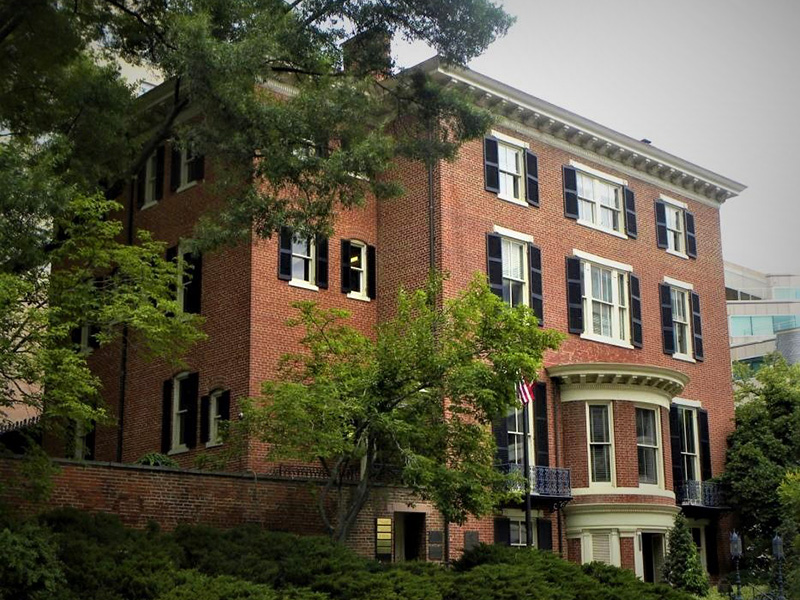
Proximity to the “President’s House” has always been an important consideration in selecting a building site in the nation’s capital. This was already true in the early 1800s, when the nation’s first powerbrokers built magnificent homes in the shadow of the newly constructed White House. They chose this location to signal their own prestige, but also to provide a degree of convenience — proximity made it easier for decisionmakers to gather informally to hash out the critical matters of the day.
The house located at 1801 F Street, today known as the DACOR Bacon House, was one such home. Completed in 1825, it is the only surviving, furnished, early private home in the “President’s Neighborhood.” What was once a neighborhood of elegant homes is now dominated by government office buildings. The DACOR Bacon House remains as an important reminder of days past.
In keeping with its history, today it serves as a center for international dialogue and is the headquarters of DACOR, an organization of foreign affairs professionals committed to the future of diplomacy and international understanding.
Architectural Significance of the House
DACOR Bacon House stands on land originally part of Prince George’s County, Maryland. Much of the parcel held by its owner, Scottish immigrant David Burnes, was sold to the federal government for construction of the White House grounds and the National Mall. Other parcels, including that occupied by the House, remained in private hands.
U.S. Marshal Tench Ringgold was the first owner to build on the site. In 1824-25 he constructed an almost square, two-and-a-half story structure on a full, above ground English-style basement. Since then the House has been significantly enlarged and thoroughly renovated several times. Yet for all the changes, it retains much of its original scale, design, craftsmanship and appeal.
The House is a stately red brick Federal mansion that today extends to four stories and 24 rooms, and includes a carriage house, a half-acre garden and bricked rear courtyard. Its integrity as an archtectural gem is protected by an easement held by the National Trust for Historic Preservation and by the committed leaders and volunteers of the DACOR Bacon House Foundation.
The Supreme Court Connection
As described by Terry Walz in a recent article in the Journal of Supreme Court History, If Walls Could Talk: the Supreme Court and DACOR Bacon House, Two Centuries of Connections, “no abode served as a home away from home more consistently or provided greater hospitality.” Clare Cushman says in her article on the subject in a recent Society Quarterly column, “His (Terry’s) article shows how important it was as a space for the justices to socialize, board, hold conferences, deliberations, and host welcome dinners for newly-appointed justices.
Tench Ringgold, the U.S. marshal for the District of Columbia (1818-1831), built the house in 1825 and invited the justices to attend social gatherings with other elites. Future chief justice Salmon P. Chase, who had recently settled in Washington to teach law classes in 1829, attended the wedding of one of Ringgold’s daughters, writing in his diary that “Wine flowed in rivers – and rivers [were] drank dry.”
Chief Justice John Marshall arranged for his brethren to board at Ringgold’s house for the 1832 Term, which lasted January through March. He shared meals with Justices Joseph Story, Gabriel Duvall, Smith Thompson, and Henry Baldwin in the dining room before retreating to the south parlor room for discussions of upcoming cases and deliberations of argued cases. The following term only Marshall and Story boarded there as other justices had begun making their own housing arrangements.
Ownership of the house was subsequently passed to former governor of Maryland Samuel Sprigg who gave it to his daughter Sally and her husband, William T. Carroll. As Clerk of the Supreme Court from 1828-1863, William invited the justices to his home for regular social gatherings. After her husband was killed in the Civil War, Sally continued to entertain Washington society, including the justices, until her death in 1895.
Molly Fuller, the wife of Chief Justice Melville Fuller (1888-1910), decided to buy the Carrolls’ residence because of its erstwhile association with Chief Justice John Marshall. She had the “south” parlor room on the second floor converted into a library and office for the chief justice. Fuller began inviting the justices to meet at the F Street house on Saturdays to hold Conference discussions of cases and to assign opinion-writing. The Fullers also gave a special dinner to welcome each newly-appointed justice to the Court and to Washington.
Chief Justice Fuller died in 1910 and eventually the house was purchased by Representative Robert Low Bacon and his wife, Virginia Murray Bacon. They continued the tradition of entertaining official Washington, including members of the Supreme Court.
About the Author: Meredith Whiting is a member of DACOR and the Supreme Court Historical Society. She is Chair of the DACOR Bacon House Building & Grounds Committee.




